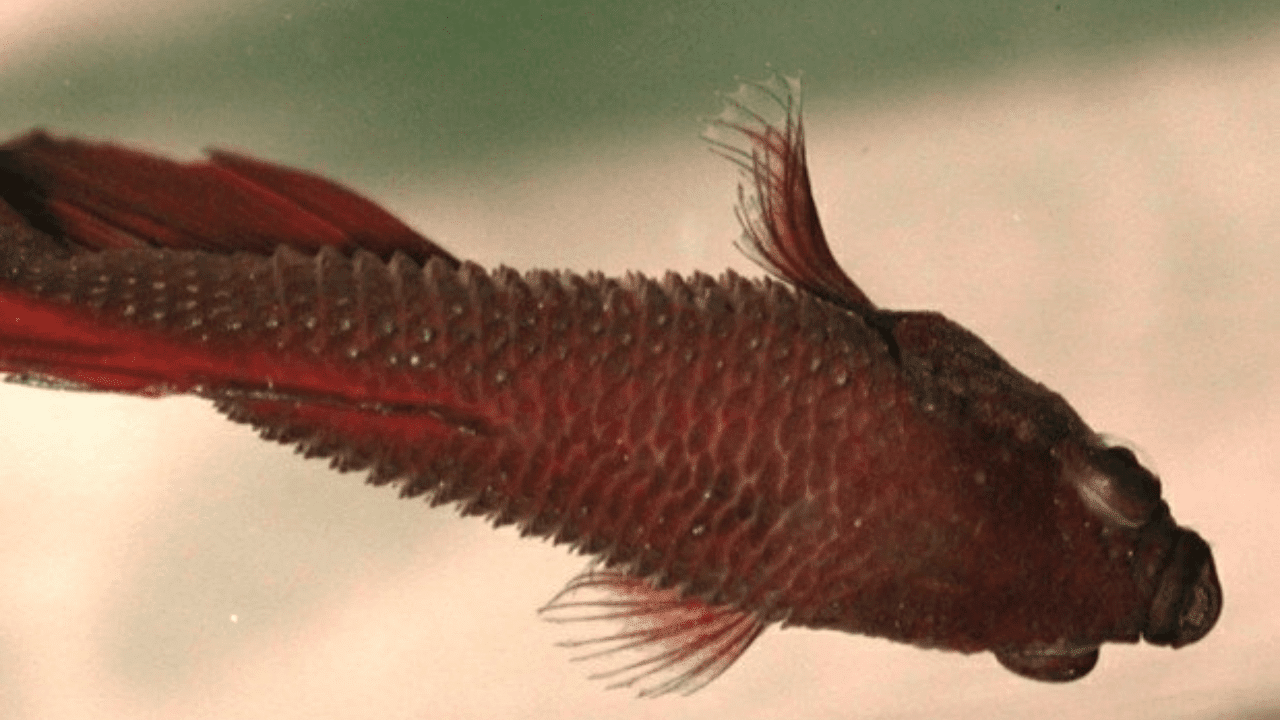
Here’s a Quick Summary
Name: Fish Dropsy, Bloat
Scientific Name: Varies based on the underlying cause, as it’s a secondary symptom
Cause: Often due to a bacterial infection, virus, or parasite
Visual Symptoms: Severe body swelling and pine-coning scales
Behavioral Symptoms: Loss of appetite, lethargy, bottom-dwelling, darting to the surface for oxygen, and lying on their side
Treatment: Use antibiotics like Kanamycin or Maracyn II
Outlook: Unfortunately, often fatal
What is Dropsy?
Dropsy in betta fish is a disease characterized by fluid building inside the body, often leading to swelling of the kidneys and organ failure.
Though the exact causes remain vague in betta keeping, it’s believed to stem from poor water quality or diseases contracted from live food. The fluid buildup causes the scales to rise, giving the flesh a pine cone appearance. Dropsy itself isn’t contagious, but the bacteria believed to cause it can spread to other fish.
Symptoms
The iconic symptom of dropsy is raised scales, which are easier to identify when viewing the fish from the top.
Other symptoms include Loss of appetite:
- Loss of appetite
- Fins clamped against the body
- Scales stand out
- Bulging eyes
- Swollen belly
- Loss of color/Pale gills
- Feces pale and stringy
- Ulcers
What Causes Dropsy in Betta Fish?
Dropsy is typically caused by a gram-negative bacterial infection.
Prolonged stress weakens the immune system, preventing it from fighting the infection. It’s also linked to kidney failure, poor diet, osmoregulation issues, and other organ infections, such as the liver.
Physical appearance changes occur due to internal swelling from fluid buildup, placing pressure on the body and abdominal area. Aging bettas are more prone to kidney failure, bacterial, and parasitic infections, increasing their risk. High bio-loads from excessive tank mates or an unsuitable ecosystem can cause harmful bacteria to manifest, while live food or inappropriate proteins may lead to digestive issues and kidney failure.
Is Dropsy in Betta Fish Contagious?
Dropsy isn’t highly contagious, but it’s still important to act quickly if a fish shows symptoms. Once a fish is diagnosed, it’s best to remove it from the aquarium to prevent contamination of the water, as the infected fish will likely deteriorate and eventually die.
If you have multiple fish, set up a quarantine or sick tank to treat the affected fish separately. This not only protects the healthy fish but also makes it easier to provide targeted care for the one that’s sick.
Potential Treatments for Dropsy
Dropsy is often fatal in advanced stages of extreme bloating, but identifying it early improves your chances of successful treatment. Use the following steps:
Setting Up a Hospital Tank
- Set up a hospital tank with a heater and thermostat, maintaining 78 degrees Fahrenheit.
- Keep the water level lower to help your betta surface for oxygen.
- Add an air stone and air pump to oxygenate the water, as antibiotics can deplete oxygen levels.
- Acclimate your betta to the hospital tank and administer the antibiotic per direction. Never stop treatment early.
Using a hospital tank simplifies dosing and prevents disruption of the nitrogen cycle in your main tank. Avoid adding treated water back into the main aquarium. If water parameters spike during treatment, use a water conditioner to detoxify ammonia, nitrite, and nitrate. Once complete, acclimate your betta back to its main habitat.
Add Aquarium Salt (Optional):
- Use 0.5 teaspoons per gallon in the hospital tank.
- Helps to reduce swelling and release built-up fluids.
- Ensure the salt is fully dissolved before adding it to the tank.
Best Medication for Dropsy
The best medications for dropsy treatment in bettas include Kanaplex from Seachem and Maracyn Two from Fritz Aquatics.
The active ingredient in Kanaplex is kanamycin, while Maracyn Two contains minocycline. These broad-spectrum antibiotics are easily absorbed through the skin and gills, making them especially helpful if the betta has stopped eating.
Kanaplex from Seachem
Strong antibiotics can affect the kidneys and liver, adding stress to a betta. Even with treatment, survival from dropsy may not be possible. It’s crucial to try treating the fish and ensuring it is comfortable.
Some betta owners might consider euthanasia, depending on the fish’s age and outlook for recovery. This decision should be made after analyzing the quality of life the betta is currently experiencing.
How to Prevent Dropsy in Bettas?
The best cure for Dropsy is prevention. Most of the factors that stress fish and make them susceptible to infection can be avoided with a little extra care. Poor water quality is often the main root cause, so keeping up with tank maintenance is absolutely critical.
Here are a few simple habits to follow:
- Do regular water changes to keep things fresh.
- Always keep the tank and filter clean.
- Avoid overcrowding—your fish need their space.
- Don’t overfeed, and use flake foods within a month of opening.
- Mix up their diet for added variety and nutrition.
When your fish are fed a healthy diet and live in a well-maintained tank, the chances of a Dropsy outbreak are very unlikely. It’s all about giving them the best environment possible to stay happy and stress-free.
Understanding the Prognosis: Is Dropsy Always Fatal?
Dropsy is often fatal, especially if detected in advanced stages, as it indicates severe internal damage. However, early diagnosis and proper treatment with antibiotics and supportive care can improve the chances of recovery. Prevention through a healthy environment is key to reducing the risk.
FAQS
Can betta be saved from dropsy?
If your betta has contracted dropsy, the prognosis is often grim, as the condition almost always leads to fatality within 15 to 20 days after contraction. That said, there’s still hope. While it’s rare, some bettas do manage to survive a battle with dropsy. Using the right methods and providing prompt care can improve their chances, even if the odds are low.
Does dropsy cause fish to float?
Yes, dropsy can cause a fish to float, but it depends on how the condition affects the fish’s internal organs. As fluid builds up in the body, it can disrupt the swim bladder, which controls buoyancy.
Should you begin medicating the betta as soon as you quarantine it?
Avoid overdosing the water with salt and medication as it can harm your fish. Start by quarantining your betta and monitor for improvement over 7 days; if no progress is made, switch to medication. While recovery isn’t guaranteed, treating dropsy carefully can sometimes result in curing your fish. Share your success if you manage to save your betta!
Worried about the lighting requirements of your Betta? Then read:
